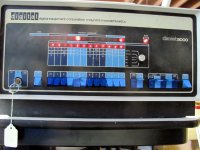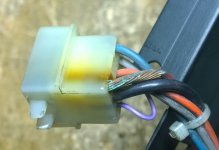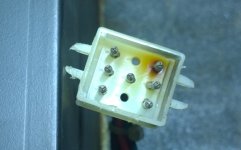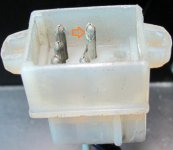DougIngraham
Veteran Member
This photo is of the rear power connector and matching cable I mentioned in a previous post.

It is kind of difficult to imagine that I never noticed this before. And it actually does work to deliver power to the rear 20 slots of backplane. Ignore the hex head screws just to the right of the connector. I am trying to.
Well, I went out to get some lunch and then do my daily walk and when I got back I could think of nothing else that needed checking so I plugged it in, flipped the breaker on and turned the key.
No drama! load address works and all bits of the PC work. pressed examine a few times and there is stuff in memory. Do it again and the same stuff comes back so memory is mostly working.
At 200 I deposited a 5200 and then made sure it was there. YES! Load address, clear, continue, and it is doing a JMP to 200. Amazing. Changed the program to a 7001 followed by a 5200 and that works too. That is an IAC followed by a JMP back to the IAC. I can single step and watch the AC increment. For all the problems with the physical stuff the CPU seems to be mostly working. Here is a current photo.

Here is the card loadout by slot.
Here is a photo I took of the front panel while it was running the IAC loop at full speed.

The front panel faceplate has a red filter on the bulbs. This one is bulbs, not LED's. I would prefer white but this is perhaps the rarest of the front panel graphics for an 8/e.
I see that the time I spent positioning the power switch was wasted once I tightened up the screws. The key is the spare from my Straight 8 I had made at a local locksmith for a couple of dollars. It always surprised me that all the machines have the same key.
Next is to put the M837 in place and verify I can reach Field 1. Then I will move the second 8k into place and verify that works too. Then it will be getting a console interface up so I can feed diagnostics to it.

It is kind of difficult to imagine that I never noticed this before. And it actually does work to deliver power to the rear 20 slots of backplane. Ignore the hex head screws just to the right of the connector. I am trying to.
Well, I went out to get some lunch and then do my daily walk and when I got back I could think of nothing else that needed checking so I plugged it in, flipped the breaker on and turned the key.
No drama! load address works and all bits of the PC work. pressed examine a few times and there is stuff in memory. Do it again and the same stuff comes back so memory is mostly working.
At 200 I deposited a 5200 and then made sure it was there. YES! Load address, clear, continue, and it is doing a JMP to 200. Amazing. Changed the program to a 7001 followed by a 5200 and that works too. That is an IAC followed by a JMP back to the IAC. I can single step and watch the AC increment. For all the problems with the physical stuff the CPU seems to be mostly working. Here is a current photo.

Here is the card loadout by slot.
- Front Panel
- M8330 Timing board
- Empty reserved for M8340 EAE
- Empty reserved for M8341 EAE
- M8310 Major Registers control
- M8300 Major Registers
- Empty reserved for M837 Extended Memory and Time Share control
- Empty reserved for M847 Hardware Bootstrap loader (Roland's version)
- Empty reserved for M8655 Terminal control. Console (and eventually the single port Serial Disk)
- Empty reserved for M8357 RX01/RX02 interface
- Empty
- Empty
- M849 RFI Shield
- G111 Sense Inhibit for 8k core
- H212 8k memory stack
- G233 8k core X-Y
- Empty reserved for second G111
- Empty reserved for second H212
- Empty reserved for second G233
- M8320 Bus Loads
Here is a photo I took of the front panel while it was running the IAC loop at full speed.

The front panel faceplate has a red filter on the bulbs. This one is bulbs, not LED's. I would prefer white but this is perhaps the rarest of the front panel graphics for an 8/e.
I see that the time I spent positioning the power switch was wasted once I tightened up the screws. The key is the spare from my Straight 8 I had made at a local locksmith for a couple of dollars. It always surprised me that all the machines have the same key.
Next is to put the M837 in place and verify I can reach Field 1. Then I will move the second 8k into place and verify that works too. Then it will be getting a console interface up so I can feed diagnostics to it.




